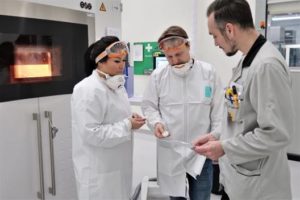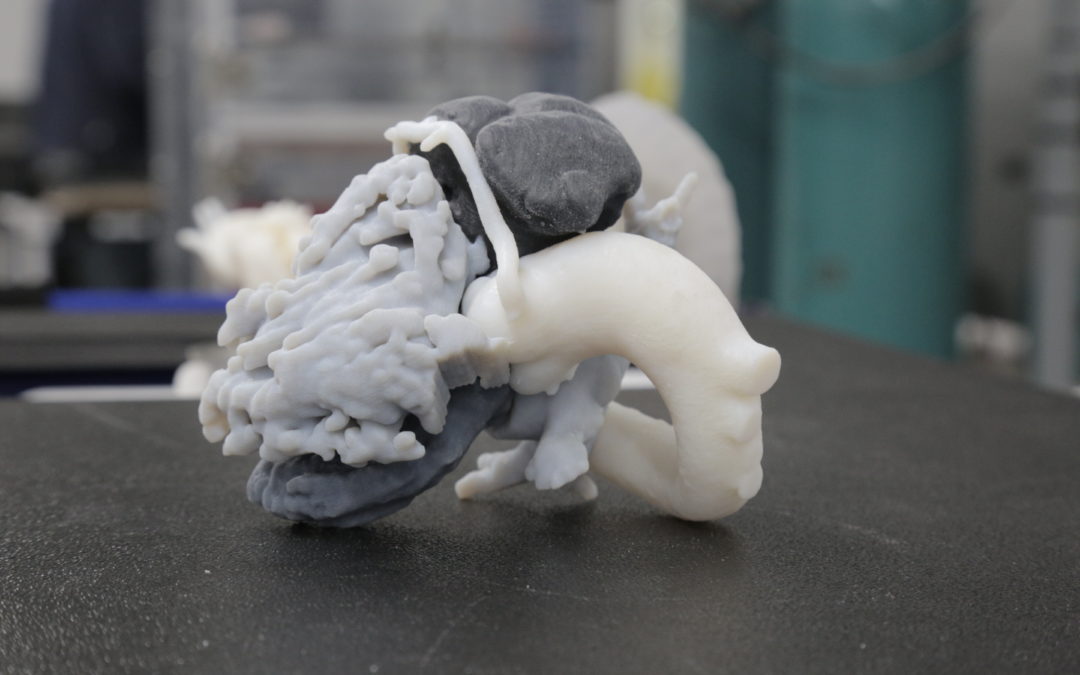GE Healthcare Life Sciences has opened a new additive manufacturing (AM) facility in Umeå, Sweden that will be dedicated to integrating 3D-printed parts into the company’s production of biomanufacturing equipment. The site will be its second such center in Sweden, the first of which was opened in Uppsala, Sweden in 2018.
Together, the two centers will be used to for every stage of 3D printing, from prototyping to serial production. While the facility in Uppsala will engage in product design and validation activities, the Umeå perform serial production on those components.
The new site features an EOS 3D printer for polyamide parts, meant for serial production, as well as a powder mixing station and post-processing equipment. GE intends to fabricate parts for such bioprocess products as the newly released launched ÄKTA go chromatography system, as well as HiScale columns and Biacore SPR systems.

GE Healthcare Life Sciences engineers next to the 3D printer in Umeå. Image courtesy of GE Healthcare Life Sciences.
Olivier Loeillot, General Manager BioProcess at GE Healthcare Life Sciences, explained that the location of these centers was decided based on the fact that the company manufactures chromatography resins and bioprocess equipment in Sweden. As a result, GE will be able to deliver its technologies more quickly. As for the choice of 3D printing, Loeillot pointed out that 3D-printed parts are “smaller and more durable” than those made with traditional technology, which translates to “better quality, less waste, and simplified designs.”
Loeillot sees the new center as improving productivity to the company’s supply chain, which will benefit from increased agility offered by 3D printing. While we are still far from on-demand manufacturing closest to the point of use, GE is at least a step closer in co-locating its additive facilities within the same region, though it would have most likely launched any new site nearest to its main hub of activities for any given technology.
Other 3D printing activities engaged in by GE Healthcare include a partnership with Formlabs to 3D print patient-specific anatomical models, a process it wishes to streamline. The company is also working with pharmaceutical giant Amgen to test the viability of a 3D-printed chromatography column.
For those following the industry, there’s no need to mention that this is part of a larger strategy on the part of GE to adopt 3D printing wherever possible across its supply chain. After pioneering 3D printing for production of fuel nozzles, then turbine blades in its aerospace division, the conglomerate began 3D printing end parts for its Oil & Gas company in Japan. What could have seemed like an elaborate and expensive marketing campaign with the highly publicized fuel nozzle proved itself to be a commitment to innovation and market dominance across its supply chain.
This most recent facility for GE Healthcare Life Sciences demonstrates that we are just at the beginning of a new era in which AM will be increasingly adopted and really will take a chunk out of the $13 trillion manufacturing sector.
The post GE Healthcare Life Sciences Opens $2M 3D Printing Center in Sweden appeared first on 3DPrint.com | The Voice of 3D Printing / Additive Manufacturing.

